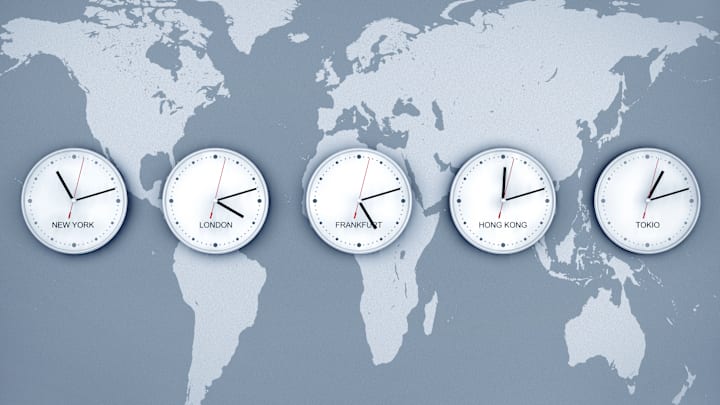Today, it’s standard to have multiple time zones around the world. But the history of how we got to this point has been fraught with a number of strong disagreements over the years—and some disputes remain unresolved to this day. Here is a chronological look at a number of different time zone disputes from the past (and occasionally the present).
- France and the UK’s Battle Over the Center of Universal Time
- Dublin’s 25-minute and 21-Second Difference
- Spain Being in the “Wrong” Time Zone
- France’s Time Change While Under Nazi Occupation
- The UK on Double Summer Time
- The Argument Over Whether We Should Have Different Time Zones at All
France and the UK’s Battle Over the Center of Universal Time

Time was not always as precisely measured as it is today, but the 19th century began to change that. The expansion of railway travel during this period meant it was necessary for people to know exactly when a train would arrive and depart—so in 1884, an international conference was held to determine a universal center of time. This event brought a long-running dispute between France and the UK back to the forefront, with each country clamoring to make a claim for its spot at this center.
The UK ultimately won. Greenwich Mean Time (GMT) took on the accolade (Greenwich being in London, the capital of the UK). France initially resisted GMT, but eventually adopted it in 1911.
Dublin’s 25-minute and 21-Second Difference

Dublin, Ireland, used to have its own time zone from 1880 to 1916. It was known as Dublin Mean Time (DMT), and was 25 minutes and 21 seconds behind GMT.
This changed in 1916 when the UK government (Ireland was part of the UK at the time) decided it would be more convenient to align the time zones in both Ireland and Britain. Some disagreed with the abolition of DMT and continued to follow it privately; such was the case with one farmer in Donegal, who kept to the old system.
Even after the Irish Free State gained its independence from the UK in 1922, time in both countries generally stayed consistent to avoid Northern Ireland becoming out of step with either country.
You May Also Like ...
- 28 Fascinating Facts About Time
- 25 Fascinating Facts About Daylight Saving Time
- 17 Facts That Will Warp Your Sense of Time
Add Mental Floss as a preferred news source!
Spain Being in the “Wrong” Time Zone

Spain used to share a time zone with Portugal and the UK. But in 1942, the dictator Francisco Franco moved the country’s time zone to the Central European Time (CET); he did this so Spain would align with Nazi Germany. Spain never returned to the old time zone, even after World War II ended.
Some have argued that the country should revert to its initial time zone, as the current situation has caused Spaniard’s body clocks to become out of sync: One report compiled by a parliamentary commission in 2013 proposed that the off-kilter body clocks are why people in Spain eat dinner and go to bed later than other Europeans. “Our timetable is determined more by the sun than by the clock. We eat at one o’clock in the afternoon and dine at eight, according to the sun, but the clock says it is three o’clock and 10 o’clock,” the report noted.
In 2013, a group of Spanish parliamentarians even discussed the prospect of formally moving Spain’s time zone, but this ultimately led nowhere.
France’s Time Change While Under Nazi Occupation

German orders caused the French to change their time zone following the Nazi occupation of France during World War II. France had been following Greenwich Mean Time; now, they were obligated to follow CET (along with other countries the Germans occupied). But some French people resisted this and continued to observe traditional French time in private.
France continued to use this time zone even after the Allies liberated France in 1944—they did this because the UK had adopted Double Summer Time (more on that below) during the war. And though France had planned to eventually return to GMT, they still use CET; seasonal clock changes were introduced in the 1970s.
The UK on Double Summer Time

The UK adopted British Summer Time from 1940 onwards; this meant that the clocks no longer fell back one hour to GMT in October as they previously had. The country adopted this method in part so that there would be more light in the evening, giving people extra time to be outside before darkness fell and any blackouts—and the threat of nighttime air raids from the enemy—began.
Double Summer Time remained until 1947, when the UK returned to the practice of changing the clocks in spring and autumn. It was revived again in 1968, when the clocks went forward in the spring but did not go back in winter. But this was a contentious experiment—officials couldn’t agree whether keeping this “double summer time” actually had more advantages than disadvantages. Parliament voted in 1971 to return to the old system.
The Argument Over Whether We Should Have Different Time Zones at All

Despite their ubiquity around the world, not everyone welcomes the concept of time zones. There are even some who have argued they should be abolished altogether. One of the arguments in favor of abolishing time zones is that it would stop people from using them as a political tool.
But there are also strong arguments against abolishing time zones. One main one is the potential health issues a lack of time zones could cause. If a large geographic area had to follow the same time zone—and the people who lived there all had to adhere to the same working hours—it would mean some parts of the population would have to start their day well before the sun rises. This would disrupt their circadian rhythm, which can lead to serious health problems.
